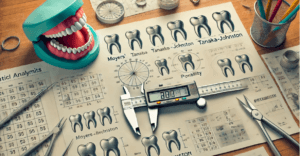How Accurate Are Moyers’ and Tanaka-Johnston’s Methods for Indian Children’s Teeth?
Predicting unerupted tooth size is essential in pediatric dentistry to prevent misalignment. This review evaluates the accuracy of Moyers’ and Tanaka-Johnston’s methods for Indian children. A systematic search of PubMed and Scopus identified 328 studies, with only 14 meeting inclusion criteria. Results showed Moyers’ method had a 20-30% acceptance rate, while Tanaka-Johnston’s method was less accurate. Studies indicated gender-based variations, with Tanaka-Johnston’s method overestimating tooth size, especially in males.
A risk of bias assessment using ROBANS 2 found most studies had a low risk of bias. Selection, performance, and detection biases were minimal, strengthening the review’s reliability. Findings suggest Moyers’ method is more suitable for Indian children. However, both methods may need modifications for better accuracy. This study highlights the importance of population-specific dental analysis. Future research should focus on developing more precise prediction models for Indian children.

How Accurate Are Moyers’ and Tanaka-Johnston’s Methods for Indian Children’s Teeth?
In pediatric dentistry, accurately predicting the size of unerupted teeth is essential to prevent malocclusion, a common condition where teeth become misaligned. A recent systematic review evaluated two widely used methods—Moyers’ and Tanaka-Johnston’s analyses—for estimating the mesiodistal width (side-to-side measurement) of unerupted canines and premolars in Indian children. These methods help dentists determine whether there is sufficient space in a child’s jaw for incoming teeth, allowing for early intervention if needed. The review revealed that while both methods are widely used, their accuracy varies significantly within this population, highlighting the need for ethnicity-specific adjustments.
Researchers adhered to rigorous guidelines such as Cochrane and PRISMA, analyzing studies from PubMed and Scopus. They used search terms like “mixed dentition” and “Indian population,” combined with Boolean operators (AND, OR, NOT), identifying 3,126 articles. After removing duplicates and irrelevant studies, only 14 met the inclusion criteria, which focused on Indian children and compared both methods. Key exclusions included 51 studies on non-Indian populations, 74 that did not use both methods, and 38 with insufficient data.
The findings revealed significant differences. Moyers’ method, which relies on probability tables based on the size of lower incisors—the first permanent teeth to erupt and known for their consistent size—showed a 20-30% acceptance rate. In contrast, Tanaka-Johnston’s method, which uses mathematical formulas, often overestimated tooth sizes, particularly in boys. Studies by Shobha et al. (2016) and Sholapurmath et al. (2012) noted that variations in male tooth size contributed to these inaccuracies.
While Moyers’ approach was generally more reliable, it occasionally underestimated results in girls, though less frequently than Tanaka-Johnston’s. The review emphasized that both methods fall under regression-based analyses, predicting unerupted teeth through equations. Other techniques, such as radiographic measurements (e.g., X-rays) and combined methods, are less commonly used in practice.
A risk of bias assessment using the ROBANS 2 tool evaluated study quality across eight domains, including participant selection and data reporting. All 14 studies demonstrated a low risk in critical areas such as selection bias (appropriate group comparisons) and detection bias (minimizing assessor influence). However, three studies (21.43%) had an unclear risk in selective outcome reporting, suggesting that some results may not have been fully disclosed. Despite this, the overall low risk supported the review’s credibility.
The findings underscore the need for population-specific adjustments. For instance, Tanaka-Johnston’s tendency to overestimate tooth size in males suggests that gender-specific formulas could improve accuracy. Likewise, Moyers’ probability tables could benefit from updates reflecting Indian dental patterns. Such refinements could enhance early diagnosis and treatment planning, ultimately reducing the risk of malocclusion.
In conclusion, Moyers’ method proved more reliable for Indian children, though both approaches have limitations. The review advocates for tailored tools in pediatric dentistry to accommodate anatomical and gender variations, ensuring better care for diverse populations. By refining existing models, future research can provide more precise predictions, leading to improved oral health outcomes through timely interventions. This study bridges a critical gap, emphasizing the importance of cultural and biological considerations in dental practice.
You must be logged in to post a comment.